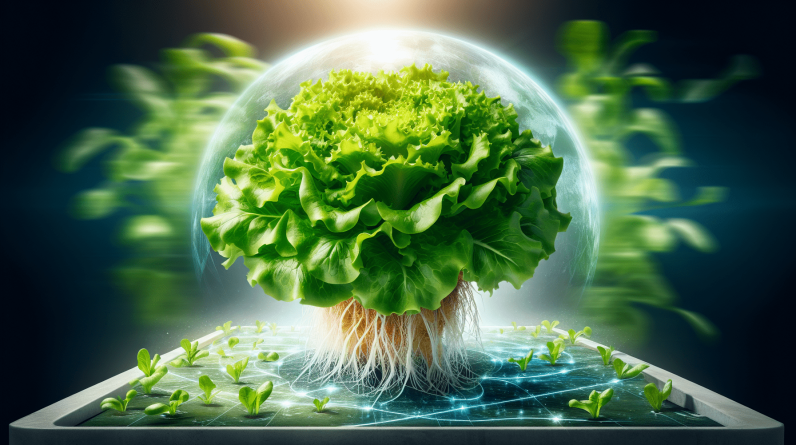
Welcome to “Sustainable Practices for Hydroponic Vegetable Gardening”! Hydroponic growing systems offer a multitude of benefits, such as faster plant growth and increased produce yields, by delivering a nutrient-rich solution directly to the roots. This method not only conserves water but also enables year-round cultivation, regardless of external weather conditions. In addition, hydroponic systems reduce the risk of soil-borne diseases and pests, leading to healthier plants and decreased chemical inputs. Overall, hydroponic vegetable gardening provides a sustainable and efficient approach to growing fresh, nutritious crops. Have you ever considered starting your hydroponic vegetable garden but weren’t sure where to begin or how to ensure sustainable practices? You’re in the right place! In this guide, you will learn all about sustainable practices for hydroponic vegetable gardening, helping you grow fresh, nutritious crops while minimizing your environmental impact. Let’s dive in!
Understanding Hydroponic Vegetable Gardening
Hydroponic vegetable gardening is a method of growing plants without soil, using a nutrient-rich water solution to provide essential nutrients directly to the roots. This method allows plants to grow faster and yield more produce compared to traditional soil gardening.
In hydroponics, plants are typically grown in a soilless medium such as perlite, coconut coir, or rockwool, which provides support for the roots while allowing them to access the nutrient solution. By eliminating the need for soil, hydroponic systems conserve water and reduce the risk of soil-borne diseases and pests.
Benefits of Hydroponic Vegetable Gardening
Hydroponic vegetable gardening offers several advantages over traditional soil gardening, making it an attractive option for both beginners and experienced gardeners. Some of the key benefits include:
- Faster plant growth and increased yields
- Reduced water usage (up to 90% less compared to soil gardening)
- Year-round cultivation regardless of external weather conditions
- Minimized risk of soil-borne diseases and pests
- Healthier plants with fewer chemical inputs
By incorporating sustainable practices into your hydroponic vegetable garden, you can further enhance these benefits and create a thriving, environmentally-friendly growing environment.
Choosing the Right Hydroponic System
When establishing a sustainable hydroponic vegetable garden, it’s essential to select the right hydroponic system that aligns with your space, budget, and gardening goals. There are several types of hydroponic systems available, each with its unique features and requirements.
Types of Hydroponic Systems
- Deep Water Culture (DWC): In this system, plants are suspended in a nutrient solution with their roots submerged. Air stones provide oxygen to the roots, promoting healthy growth.
- Nutrient Film Technique (NFT): Plants are placed in channels with a constant flow of nutrient solution running over the root system. This system is well-suited for leafy greens and herbs.
- Ebb and Flow (Flood and Drain): A tray is periodically flooded with a nutrient solution, which then drains back into the reservoir. This system is versatile and suitable for a variety of crops.
- Drip System: Nutrient solution is delivered to the roots through drip emitters or tubing, providing precise control over the watering schedule.
- Aeroponics: Roots are suspended in the air and misted with a nutrient solution, allowing for maximum oxygenation and nutrient absorption.
Considerations for Sustainable Hydroponic Systems
When choosing a hydroponic system for your vegetable garden, keep the following sustainability factors in mind:
- Energy efficiency: Opt for systems that minimize energy consumption, such as LED grow lights and energy-efficient water pumps.
- Water conservation: Choose systems that recycle and conserve water to reduce overall usage.
- Material sustainability: Select systems made from eco-friendly materials that are durable and reusable.
- Space utilization: Consider the space available for your hydroponic garden and choose a system that maximizes growing capacity without wasting resources.
By selecting a hydroponic system that prioritizes sustainability and efficiency, you can create a productive and eco-friendly garden space that produces high-quality vegetables year-round.

Sustainable Nutrient Management
One of the key components of successful hydroponic vegetable gardening is proper nutrient management. In hydroponic systems, plants rely on a carefully balanced nutrient solution to thrive and produce healthy crops. By implementing sustainable nutrient management practices, you can ensure optimal plant growth while minimizing waste and environmental impact.
Essential Nutrients for Hydroponic Vegetables
Plants grown in hydroponic systems require a specific balance of essential nutrients to support their growth and development. These nutrients can be categorized into two groups: macronutrients and micronutrients.
Macronutrients:
- Nitrogen (N)
- Phosphorus (P)
- Potassium (K)
- Calcium (Ca)
- Magnesium (Mg)
- Sulfur (S)
Micronutrients:
- Iron (Fe)
- Manganese (Mn)
- Zinc (Zn)
- Copper (Cu)
- Boron (B)
- Molybdenum (Mo)
Sustainable Nutrient Solutions
To maintain a sustainable hydroponic vegetable garden, consider the following nutrient management practices:
- Use organic and environmentally-friendly nutrient solutions to minimize chemical inputs and reduce environmental impact.
- Regularly monitor and adjust the pH and nutrient levels of the solution to ensure optimal plant growth and nutrient uptake.
- Implement a nutrient recycling system to reuse excess nutrient solution and reduce waste.
- Choose slow-release or time-released nutrient formulations to provide a steady supply of nutrients to the plants over time.
By prioritizing sustainable nutrient management techniques in your hydroponic garden, you can promote healthy plant growth, minimize resource consumption, and produce high-quality vegetables with minimal environmental impact.
Water Conservation Strategies
Water conservation is a critical aspect of sustainable hydroponic vegetable gardening, as efficient water usage helps reduce environmental impact and operating costs. By implementing water-saving strategies in your hydroponic system, you can minimize water waste and create a more sustainable growing environment.
Water-Saving Techniques for Hydroponic Gardens
- Recirculate the nutrient solution: Instead of constantly replenishing the water supply, recirculate the nutrient solution through the system to reduce water consumption.
- Implement a drip irrigation system: Drip emitters deliver water directly to the plant roots, minimizing runoff and ensuring efficient water usage.
- Collect and reuse runoff water: Capture excess nutrient solution runoff and reuse it in the system to conserve water and nutrients.
- Monitor and adjust watering schedules: Regularly check the moisture levels in the growing medium and adjust the watering schedule to prevent overwatering and water waste.
Rainwater Harvesting for Hydroponic Gardens
An effective way to supplement your hydroponic garden’s water supply is by harvesting rainwater. By collecting rainwater in storage tanks or barrels, you can reduce your reliance on municipal water sources and conserve resources.
Benefits of rainwater harvesting for hydroponic gardens:
- Free and abundant water supply
- Reduced reliance on municipal water sources
- Minimized environmental impact
- Enhanced water quality for plant growth
By incorporating water conservation strategies and rainwater harvesting techniques into your hydroponic garden, you can promote sustainability, reduce water usage, and create a more eco-friendly growing environment.

Sustainable Pest and Disease Management
Pest and disease management is a crucial aspect of maintaining a healthy hydroponic vegetable garden. By implementing sustainable pest control and prevention methods, you can protect your crops from harmful insects and pathogens while minimizing the need for chemical interventions.
Integrated Pest Management (IPM) Strategies
Integrated Pest Management (IPM) is an environmentally-friendly approach to pest control that combines various methods to prevent and manage pests effectively. Some key components of sustainable IPM strategies for hydroponic gardens include:
- Biological control: Introduce beneficial insects or organisms that prey on pest species to control infestations naturally.
- Cultural controls: Implement cultural practices such as crop rotation, sanitation, and companion planting to prevent pest buildup and disease spread.
- Mechanical controls: Use physical barriers, traps, or exclusion methods to deter pests from accessing your plants.
- Natural pesticides: Utilize organic, plant-based pesticides or insecticidal soaps to manage pest populations while minimizing harm to beneficial insects.
Disease Prevention and Control
Preventing and managing diseases in hydroponic vegetable gardens is essential to maintaining plant health and productivity. Some sustainable practices for disease prevention and control include:
- Ensure proper air circulation and ventilation to reduce humidity and prevent fungal growth.
- Regularly sanitize equipment and growing containers to prevent the spread of pathogens.
- Monitor plant health and address any signs of disease promptly to prevent outbreaks.
- Use disease-resistant plant varieties to minimize susceptibility to common pathogens.
By implementing sustainable pest and disease management practices in your hydroponic garden, you can protect your crops, promote plant health, and reduce the need for chemical treatments, creating a more eco-friendly growing environment.
Energy Efficiency in Hydroponic Gardening
Energy efficiency is a critical aspect of sustainable hydroponic gardening, as reducing energy consumption helps lower operating costs and minimize environmental impact. By incorporating energy-saving practices into your hydroponic system, you can create a more sustainable growing environment and increase your garden’s overall efficiency.
Energy-Saving Tips for Hydroponic Gardens
- Use LED grow lights: LED lights are energy-efficient and provide the ideal spectrum of light for plant growth, reducing energy consumption and operating costs.
- Optimize light schedules: Adjust the duration and intensity of grow lights based on plant needs to maximize energy efficiency.
- Utilize timers and controllers: Install timers and controllers for lighting, water pumps, and other equipment to automate tasks and reduce energy waste.
- Insulate growing areas: Proper insulation can help maintain temperature and humidity levels, reducing energy usage for climate control.
- Incorporate renewable energy sources: Consider integrating solar panels or wind turbines to power your hydroponic system with clean and renewable energy.
Calculating Energy Consumption
To determine the energy efficiency of your hydroponic garden, consider calculating the energy consumption of key components such as lighting, water pumps, and climate control systems. By monitoring and optimizing energy usage, you can identify areas for improvement and implement strategies to reduce waste and increase efficiency.
By prioritizing energy efficiency in your hydroponic vegetable garden, you can lower operating costs, minimize environmental impact, and create a more sustainable growing environment that supports healthy plant growth and high-quality crop production.

Creating a Sustainable Hydroponic Garden
Building a sustainable hydroponic garden involves integrating various practices and techniques to promote environmental stewardship, resource conservation, and plant health. By incorporating the following sustainable strategies into your hydroponic system, you can create a productive and eco-friendly garden space that yields fresh, nutritious vegetables year-round.
Sustainable Hydroponic Garden Checklist
- Choose a hydroponic system that prioritizes sustainability and efficiency.
- Implement nutrient management practices that minimize waste and promote plant health.
- Incorporate water conservation strategies to reduce water usage and promote resource conservation.
- Adopt pest and disease management techniques that minimize chemical inputs and preserve plant health.
- Focus on energy efficiency by reducing energy consumption and utilizing renewable energy sources.
By following these sustainable practices and integrating them into your hydroponic vegetable garden, you can create a thriving, environmentally-friendly growing environment that produces high-quality crops while minimizing your environmental footprint.
In conclusion, sustainable practices for hydroponic vegetable gardening offer a holistic approach to growing fresh, nutritious crops while prioritizing environmental stewardship and resource conservation. By implementing these strategies in your hydroponic system, you can create a sustainable and efficient garden space that supports healthy plant growth and sustainable crop production. Happy gardening!










